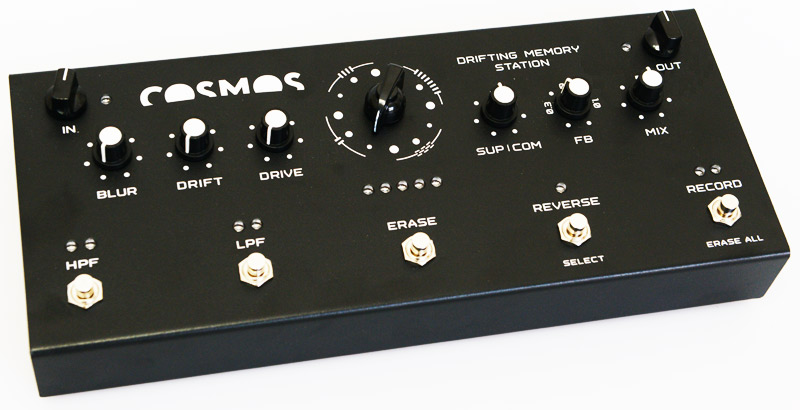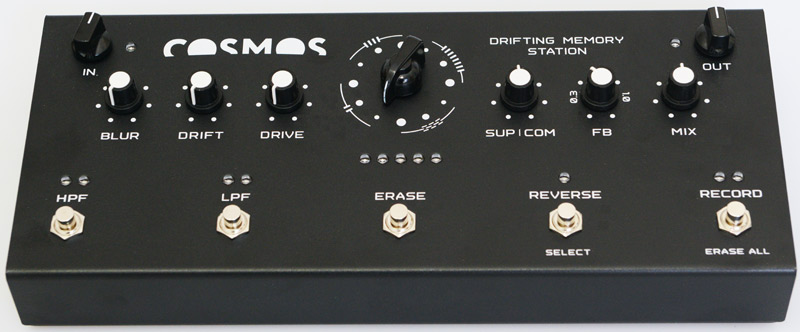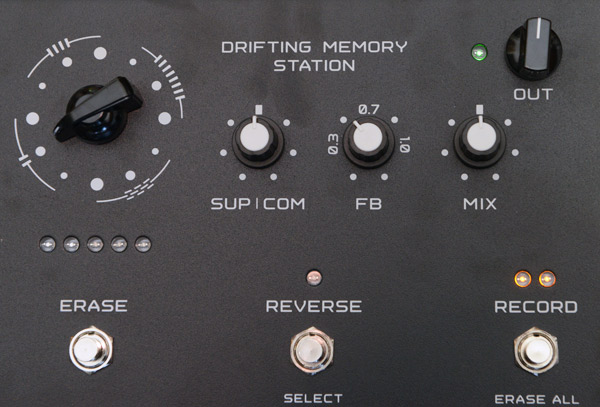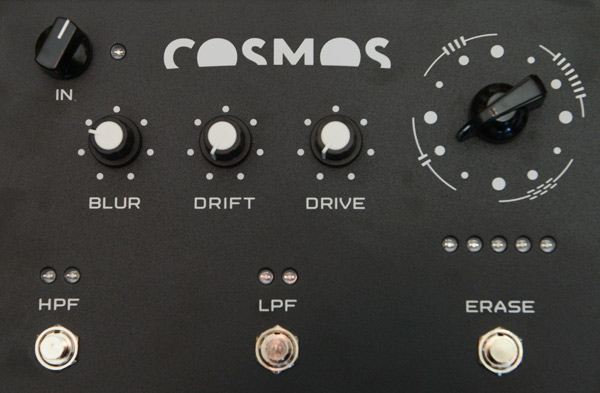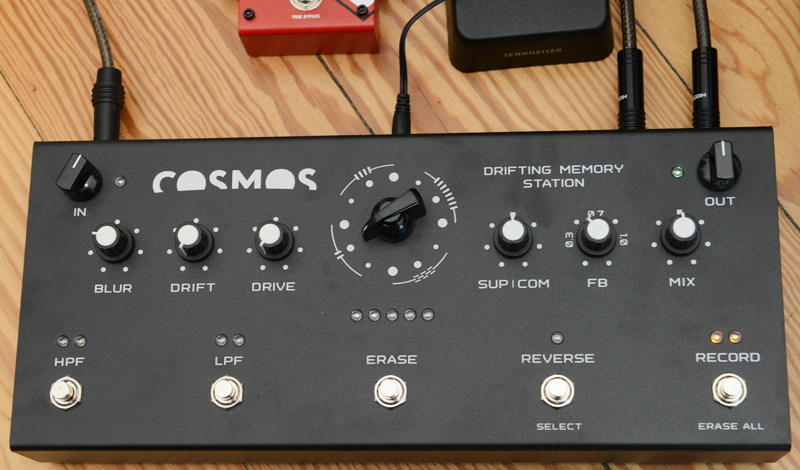SOMA COSMOS
Drifting Memory Station
Author and photos: Peter Kaminski
The COSMOS from SOMA Laboratory has been on the market since 2021, but I think you shouldnˊt always look for something new because there are enough products that have been on the market for a long time, but are no less interesting. The word “looper” might be the first thing that comes to mind when thinking of the COSMOS, but it doesnˊt really describe the device. SOMA's own description “Drifting Memory Station” is a better way to define its function.
SOMA Laboratory is a manufacturer that develops various electronic instruments that all somehow have an organic feel and are, above all, suitable for live use. Always with touches of experimental and special. To name just a few, the PULSAR-23 drum machine, the Lyra-8 synthesizer or The Pipe - a voice-controlled synthesizer. The developer Vlad Kreimer himself is an electronic music composer, and this is evident in the products. SOMA was founded by Vlad Kreimer in 2016. SOMA is ofRussian origin, but for some time now the products have been developed and manufactured in Poland.
Frippertronics
First, letˊs take a look back at the last millennium. Robert Fripp, a guitarist who was a constant member of King Crimson, among other bands, and is considered by Rolling Stone magazine to be one of the hundred best guitarists of all time, began experimenting with a certain effect in 1972 that he himself called “Frippertronics”. None other than Brian Eno took part in the experiments, which involved two Revox A77 tape recorders. Digital delays or digital storage did not exist at the time. The first tape recorder recorded the signal, while the second played it back. The tape was laid out in such a way that it was unwound from device 1 and rewound on device 2. This resulted in a large time offset during playback. The delayed signal was then fed back to the input of the first tape machine via a mixer next to the existing input signal. This technique was then used in several guitar ambient albums by Robert Fripp and was also a trademark of his ambient compositions. Today, of course, this workflow can be realized digitally with less effort and more flexibility.
This concept, in which a signal is looped with a fixed delay time, i.e., a length that is not tied to a beat or otherwise synchronized, can also be found in the COSMOS main firmware. In principle, the Frippertronics concept can also be found in a whole range of other loopers and effect devices; however, in the COSMOS, this concept has been further expanded, and there are also algorithms other than those based on Frippertronics. We will see this in more detail later.
Connectors
Letˊs take a closer look at the hardware. The COSMOSˊs housing is made of painted sheet steel (342 x 153 x 68 mm, 2.2 kg) as a floor-pedal device. However, itis also suited for desktop use. The device is powered by an external power supply (12 V DC, current consumption 0.25 A). The power supply connection is located on the backside next to the power switch.
The device is based on DSP technology, and the sampling rate is 48 kHz. 24-bit A/D and D/A converters from Cirrus Logic are used. The internal DSP calculation is performed using 32-bit floating-point word length.
The COSMOS is stereophonic and has two jack plugs for both inputs and outputs. If you only plug in one input - i.e. use it in mono mode - the signal is then routed to both internal inputs. The manufacturer specifies a minimum input voltage of 0.35 Vpp (approx. -16 dBu) and a maximum output voltage of 11.3 Vpp (approx. 14.3 dBu). The input impedance is 50 kiloohm.
The headphone output is in the form of a 6.3-mm stereo jack socket with a maximum output voltage of 10.4 Vpp.
A USB 2.0 socket can be used to connect a FAT32-formatted USB stick to load the firmware. This does not necessarily require an update, but rather there are different firmware versions for different application scenarios. If a firmware file is located in the root directory of the inserted USB stick, will be loaded by pressing the RECORD button and the turning on the device.
Operation
Now to the operation. The algorithm is set using a large, twelve-position rotary switch in the center. More details will be provided on this later. The knobs for input sensitivity and output level are located at the top left and right. The LED indicator next to the In knob lights green at the peaks. When it is red, the input converter is overloaded. The LED next to the Out knob indicates that the device is in operation and does not have a level indicator function. The loop level is displayed by a five-stage LED bar graph. If the bar graph lights red, a limiter is activated internally.
The bottom part has five buttons for a high-pass and low-pass filter, for erasing recorded material, for playing back in reverse, and for starting and stopping recording. The filters can be operated at three different cut-off frequencies. Switching is done using the REVERSE/SELECT button and confirmation of the corresponding filter button. A simple press on one of the buttons switches the respective filter on or off. The ERASE button can be used to delete temporary areas. Pressing ERASE and RECORD simultaneously deletes the entire memory.
It is also possible to mix the two inputs into a mono signal and then feed it to both input channels. This can be achieved temporarily by pressing the HPF, ERASE, and RECORD buttons simultaneously. A noise gate is also active for the input signal. The threshold can be temporarily increased by pressing HPF, LPF, and ERASE simultaneously.
The right-hand side of the user interface is the MIX knob, which determines the ratio of the input signal to the loop signal. The FB knob is used to set the degree of feedback. The COSMOS also offers two functions for dynamic processing. The so-called suppressor is used to attenuate signals that have already been recorded in relation to newly incoming signals, and there is also a classic compressor. Depending on the position of the SUP|COM control, the suppressor (to the left of the 12 o'clock position) or the compressor (to the right of the 12 o'clock position) is activated at the corresponding effect level.
The three knobs on the left side of the COSMOS display different functions depending on the algorithm, or sometimes no function at all. The DRIVE knob can be used to achieve targeted saturation or overdrive, where the signal is slightly compressed and distorted. However, this knob also has a different function for certain firmware variants.
Firmware versions
There are currently five different firmware versions:
- standard version,
- standard version with pitch shift function,
- rhythm version,
- rhythm version with pitch shift function,
- Quadrophonic version for use with two COSMOS.
The quadrophonic version is used in conjunction with a four-channel application and two COSMOS, one for the front and the other for the rear channels. The standard version is used for the front channels and the special quad firmware for the COSMOS of the two rear channels. In firmware versions with a pitch shift function, the DRIVE knob can be used to tune the pitch of the recorded or played signal down by up to half an octave. This also changes the sound in the LoFi direction.
Standard firmware
The standard (main) firmware version includes four algorithm types, each with three different levels or characteristics:
- 2 delay lines,
- 4 delay lines,
- giant reverb,
- Granular Delay.
We already mentioned the “Frippertronics” effect at the beginning. This is exactly what the first algorithm does with two delay lines that have a fixed, predefined time, i.e., they are not clock-related but rather as when used with the two tape machines. The three variants allow fixed delay times of 2.5, 9.5, and 22 seconds to be set. The BLUR knob can be used to set a crossfeed between the two delay lines. The DRIFT knob can be used to modulate the panorama with an asynchronous LFO. The LFO frequency is modulated by a random signal.
The second algorithm comprises four delay lines rather than just two. The three variants offer fixed delay times of 2.5, 8.5, and 11.5 seconds.
The Gigant Reverb simulates a virtual hall several kilometers in size. The early reflections therefore sound like individual reflections, and the signal then slowly increases in density. The three variants can be used to simulate halls of different sizes. The BLUR and DRIFT knobs have no functions in this case.
The fourth algorithm is an asynchronous granular stereo delay. The three variants offer different grain sizes and delay times. The third variant also has an additional granular delay. The BLUR knob can be used to modulate the position of the grain with a noise or random signal, and the DRIFT knob can be used to modulate the grain with an asynchronous LFO.
Rhythmic Firmware
The Rhythmic firmware is an alternative and offers, among other things, algorithms that are more based on beat-based looper functions, which means that the RECORD button not only switches to recording but also defines the loop points. Program 1 behaves like a standard looper. In programs 2 and 3, there is a difference in the length between the left and right channels (8/7 and 4/3). Programs 4 to 8 are manglers. The recorded material is rhythmically interrupted. Program 9 is a fractal shift pitch shifter. Programs 10 to 12 are the best of the main firmware and represent the main programs 4 (4 delay lines, short delay), 8 (reverb with medium delay), and 12 (3-stage granular delay).
The BLUR knob can be used to add reverb to programs 1 to 9. The DRIFT knob can be used to add an octave down random shift to programs 7 and 8, and the pitch shift itself can be adjusted in program 9.
Practice
The main firmware makes it easy to use. The rhythmic version is a little more complex with its various functions, but youˊll soon get used to it.
The feedback parameter is particularly important for loopers. The degree of feedback can be adjusted very finely on the COSMOS using the knob. The important feedback 1 point can also be checked and readjusted.
The sounds achieved using the various algorithms are impressive. The Rhythmic firmware makes the range of applications more specialized but also more flexible. Programs 7 to 9 with the Rhythmic firmware are more specialized.
As I mentioned earlier, there are other loopers or effect modules with Frippertronics effects but the COSMOS simply goes a few steps further and is more flexible than the loopers I know with such or similar functions. Changes from one firmware to another is quick and reliable. I always have a few USB sticks with the firmware versions I use, so I can quickly switch over in a few seconds.
The fixed looping time of the main firmware, which is not tied to a rhythm, yields interesting polyrhythmic patterns. You can use COSMOS with a wide range of sources, from modular synthesizers or keyboards, electric guitars, but also very well with vocals in the form of speech and singing. I can well imagine that wind and string instruments picked up by a microphone and amplified accordingly would work very well. The range of applications is even greater with the Rhythmic firmware because then percussive instruments, drums, etc. can also be used very well in conjunction with the COSMOS. The result is extremely complex polyrhythms.
Cosmos can be used in both live and studio applications. Switching between algorithms does not cause cracking or sound dropouts. You can hear the transition; thus,it is relatively smooth, so that you can even dare to change the algorithm in a concert and play around with it without having to mute the instrument at the mixer. The buttons are also of high quality and are easy to press. This means that desktop use in the studio is just as practical as use as a foot pedal.

SOMA also offers a matching cover for the COSMOS, which still allows access to the connection jacks. The device can remain connected when the cover is placed. A transport bag and cotton textile cover are also available as accessories.
Conclusion
The price is around 700 euros. Since summer 2023, COSMOS has been available in different colors, which I would describe as follows: white, red/orange, pink, light green, sky blue.
The workmanship is top-notch, and the possibilities go beyond those of normal loopers, and COSMOS offers completely different ways of working. Sound designers and musicians in the field of ambient or film composers will especially enjoy COSMOS, and anyone who enjoys sound experiments will be delighted by the results, which are really convincing. COSMOS is very versatile, from soundscapes and textures to effects and the generation of complex polyrhythms. Like other instruments and products from SOMA, it is special, but in a positive sense. I don't know which other products I could use to create these amazing sounds.
 How to resolve AdBlock issue?
How to resolve AdBlock issue? 